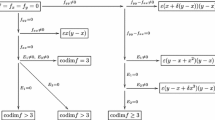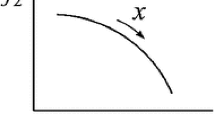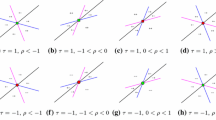Abstract
We apply singularity theory to classify monomorphic singular points as they occur in adaptive dynamics. Our approach is based on a new equivalence relation called dimorphism equivalence, which is the largest equivalence relation on strategy functions that preserves ESS singularities, CvSS singularities, and dimorphisms. Specifically, we classify singularities up to topological codimension two and compute their normal forms and universal unfoldings. These calculations lead to the classification of local mutual invasibility plots that can be seen generically in systems with two parameters.













Similar content being viewed by others
References
Damon J (1984) The unfolding and determinacy theorems for subgroups \(A\) and \(K\). Memoirs of the American Mathematical Society, vol 306
Dercole F, Rinaldi S (2008) Analysis of evolutionary processes, the adaptive dynamics approach and its applications. Princeton University Press, Princeton
Dieckmann U, Doebeli M, Metz JAJ, Tautz D (2004) Adaptive speciation. Cambridge Studies in Adaptive Dynamics
Dieckmann U, Law R (1996) The dynamical theory of coevolution: a derivation from stochastic ecological processes. J Math Biol 34:569–612
Dieckmann U, Metz JAJ (2006) Surprising evolutionary predictions from enhanced ecological realism. Theor Popul Biol 69:263–281
Diekmann O (2003) A beginner’s guide to adaptive dynamics. Banach Center Publ 63:47–86
Geritz SAH, Kisdi É, Meszéna G, Metz JAJ (1998) Evolutionarily singular strategies and the adaptive growth and branching of the evolutionary tree. Evol Ecol 12:35–57
Geritz SAH, van der Meijden E, Metz JAJ (1999) Evolutionary dynamics of seed size and seedling competitive ability. Theor Popul Biol 55:324–343
Geritz SAH, Metz JAJ, Kisdi É, Meszena G (1997) Dynamics of adaptation and evolutionary branching. Phys Rev Lett 78:2024–2027
Golubitsky M, Guillemin V (1974) Stable mappings and their singularities, GTM 14. Springer-Verlag, New York
Golubitsky M, Schaeffer DG (1985) Singularities and groups in bifurcation theory: vol 1. Applied mathematical sciences, vol 51. Springer, New York
Hofbauer J, Sigmund K (2003) Evolutionary game dynamics. Bull AMS 40:479–519
Ito HC, Dieckmann U (2012) Evolutionary-branching lines and areas in bivariate trait spaces. Evol Ecol Res 14:555–582
Kisdi E, Priklopil T (2011) Evolutionary branching of a magic trait. J Math Biol 63:36–397
Maynard-Smith J, Price GR (1973) The logic of animal conflict. Nature 246:15–18
Metz JAJ, Geritz SAH, Meszna G, Jacobs FJA, van Heerwaarden JS (1996) Adaptive dynamics, a geometrical study of the consequences of nearly faithful reproduction. In: van Strien SJ, Verduyn Lunel SM (eds) Stochastic and spatial structures of dynamical systems. North-Holland, Adam, pp 183–231
Priklopil T (2012) On invasion boundaries and the unprotected coexistence of two stategies. J Math Biol 64:1137–1156
Polechova J, Barton NH (2005) Speciation through competition: a critical review. Evolution 59:1194–1210
Vutha A (2013) Normal forms and unfoldings of singular strategy functions. Thesis, Department of Mathematics, The Ohio State University
Vutha A, Golubitsky M (2014) Normal forms and unfoldings of singular fitness functions. Dyn Games Appl. doi:10.1007/s13235-014-0116-0
Wang X (2015) Singularity theory of strategy functions under dimorphism equivalence. Thesis, Department of Mathematics, The Ohio State University, 2015. Available at http://people.mbi.ohio-state.edu/golubitsky.4/reprint-0.5/output/entireyr.html
Waxman D, Gavrilets S (2005) 20 questions on adaptive dynamics. J Evol Biol 18:1139–1154
Acknowledgments
The idea of using singularity theory methods to study adaptive dynamics originated in a conversation with Ulf Dieckmann. We thank Odo Diekmann for suggesting the study of dimorphisms using singularity theory and Ian Hamilton, Yuan Lou, Adrian Lam, and Hans Metz for many helpful discussions. This research was supported in part by the National Science Foundation Grants DMS-1008412 to MG and DMS-0931642 to the Mathematical Biosciences Institute.
Author information
Authors and Affiliations
Corresponding author
Rights and permissions
About this article
Cite this article
Wang, X., Golubitsky, M. Singularity theory of fitness functions under dimorphism equivalence. J. Math. Biol. 73, 525–573 (2016). https://doi.org/10.1007/s00285-015-0958-0
Received:
Revised:
Published:
Issue Date:
DOI: https://doi.org/10.1007/s00285-015-0958-0




